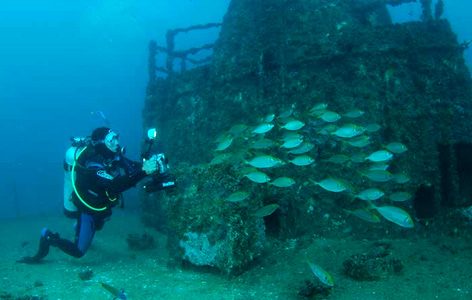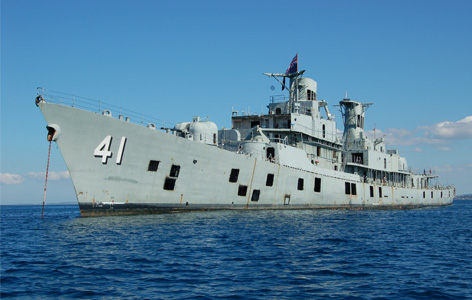If diving is your thing, then you need to look deep into HMAS Brisbane

Whilst HMAS Brisbane certainly made the news when she was unceremoniously scuttled to take on her new role as an artificial reef, she doesn’t tend to make too many headlines these days. However if you’re a certified diver looking for a great dive experience, the scuttlebutt is that there’s a great undersea adventure awaiting you just 2.9 nautical miles east of Mudjimba Island off the Sunshine Coast.
Commissioned into the Royal Australian Navy in 1967 the HMAS Brisbane was a 133 metre, Charles F Adams Class DDG, guided missile destroyer of approx 5000 tons. For 34 years she served Australia faithfully until she was decommissioned in 2001. HMAS Brisbane and her many crews, served bravely for some decades in both the Vietnam and Gulf wars and in her downtime assisted on many peace missions including supporting the cleanup of cyclone Tracey’s aftermath in Darwin in 1974.
In January 2003, the Queensland Government agreed to accept the decommissioned HMAS Brisbane from the Commonwealth Government for sinking off the Sunshine Coast. It was designated to become an artificial reef and tourist dive site.

After much careful preparation, on 31 July 2005 explosives were detonated and within just 2 minutes and 10 seconds, the former HMAS BRISBANE was sitting on the bottom in 28 metres of ocean.
With good water clarity and minimal swell, today HMAS Brisbane rests in an upright position showing 15 metres of water above her forward decks and 18 metres over her stern, it really has become a perfect diving environment. Even some of HMAS Brisbane’s ex servicemen have literally gone overboard in their praise of this great diving experience.
The Environmental Protection Agency commissioned environmental studies by scientists from both the University of the Sunshine Coast and Queensland Museum to survey the marine life that calls HMAS Brisbane home.
A school of predatory yellow tailed king fish hunt the schools of bait fish that surround the HMAS Brisbane. Other local inhabitants include a large bull & eagle rays, angler fish, lion fish, blennies, nudibranchs, sea hares, squid along with schools of juvenile red emperor and snapper. Other visitors include a shovelled nose rays, greasy cod and eagle rays. An octopus has made a home in a pyrotechnic tube on the deck.
Up to 10 huge Queensland grouper have been seen at one time off the bow of the ship. A turtle has taken up residency on the aft funnel and eagle rays cruise between the 2 funnels. There’s also a huge amount of soft corals to be seen and hard corals are really getting established as well.
There is certainly a lot of ship to see. Just cruising around the outside, its sheer size makes it an awesome sight. Water temperatures range from 17C in winter to a summer high of 27C. Visibility averages around 15 metres but up to 20 metres or more is not uncommon.
Sunreef Dive would seem to be the most privileged of the companies servicing this dive site as they have been issued a licence by the Environment Protection Agency of the Queensland Government to conduct dive trips on the former HMAS Brisbane.
This has given Sunreef exclusive use of the two mid-ship moorings, arguably the best spot to dive from as it makes for a very easy and relaxed dive.
If you go to their website they talk of “making your descent to the Mag deck between the two funnels and then take a leisurely swim to the bow or stern. This allows for 2 relaxed dives covering the whole wreck. No frantic rushed swim from one end to the other, which is the case if diving from the other moorings.”
All said and done the dive sounds like a phenomenal experience.

No comments yet.